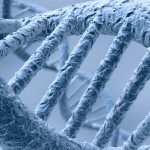Lien vers Pubmed [PMID] – 18614525
Mol. Biol. Evol. 2008 Sep;25(9):2031-41
Cyanobacteria of the genus Microcystis are known to produce secondary metabolites of large structural diversity by nonribosomal peptide synthetase (NRPS) pathways. For a number of such compounds, halogenated congeners have been reported along with nonhalogenated ones. In the present study, chlorinated cyanopeptolin- and/or aeruginosin-type peptides were detected by mass spectrometry in 17 out of 28 axenic strains of Microcystis. In these strains, a halogenase gene was identified between 2 genes coding for NRPS modules in respective gene clusters, whereas it was consistently absent when the strains produced only nonchlorinated corresponding congeners. Nucleotide sequences were obtained for 12 complete halogenase genes and 14 intermodule regions of gene clusters lacking a halogenase gene or containing only fragments of it. When a halogenase gene was found absent, a specific, identical excision pattern was observed for both synthetase gene clusters in most strains. A phylogenetic analysis including other bacterial halogenases showed that the NRPS-related halogenases of Microcystis form a monophyletic group divided into 2 subgroups, corresponding to either the cyanopeptolin or the aeruginosin peptide synthetases. The distribution of these peptide synthetase gene clusters, among the tested Microcystis strains, was found in relative agreement with their phylogeny reconstructed from 16S-23S rDNA intergenic spacer sequences, whereas the distribution of the associated halogenase genes appears to be sporadic. The presented data suggest that in cyanobacteria these prevalent halogenase genes originated from an ancient horizontal gene transfer followed by duplication in the cyanobacterial lineage. We propose an evolutionary scenario implying repeated gene losses to explain the distribution of halogenase genes in 2 NRPS gene clusters that subsequently defines the seemingly erratic production of halogenated and nonhalogenated aeruginosins and cyanopeptolins among Microcystis strains.



